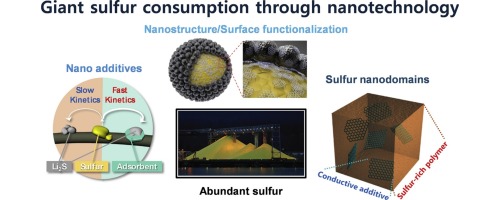当前位置:
X-MOL 学术
›
Nano Today
›
论文详情
Our official English website, www.x-mol.net, welcomes your feedback! (Note: you will need to create a separate account there.)
Design of structural and functional nanomaterials for lithium-sulfur batteries
Nano Today ( IF 17.4 ) Pub Date : 2018-02-01 , DOI: 10.1016/j.nantod.2017.12.010 Jungjin Park , Seung-Ho Yu , Yung-Eun Sung
Nano Today ( IF 17.4 ) Pub Date : 2018-02-01 , DOI: 10.1016/j.nantod.2017.12.010 Jungjin Park , Seung-Ho Yu , Yung-Eun Sung

|
Abstract Over the last decade, lithium–sulfur (Li–S) batteries have been extensively studied because of the abundance of sulfur, their environmental benignity, and high gravimetric (2600 W h kg−1) and volumetric (2800 W h L−1) energy densities. However, their unique electrochemical behavior involving the formation of dissolved polysulfide intermediate species and the insulating nature of sulfur and Li2S are the main drawbacks that must still be overcome. To tackle these limitations, solutions such as appropriate cathode architecture design, electrolyte optimization, and lithium metal stabilization have been proposed. Recently, high areal sulfur loading, a high sulfur content, and a high electrolyte-to-sulfur ratio have also become prominent issues for the commercialization of the Li–S batteries. This paper reviews a wide range of reports on the design of structural and functional nanomaterials for Li–S batteries and suggests future research directions.
中文翻译:

锂硫电池结构和功能纳米材料的设计
摘要 在过去的十年中,锂硫 (Li-S) 电池由于硫含量丰富、环境良性以及高重量 (2600 W h kg-1) 和体积 (2800 W h L-1 ) 能量密度。然而,它们独特的电化学行为涉及溶解的多硫化物中间体的形成以及硫和 Li2S 的绝缘性质是仍然必须克服的主要缺点。为了解决这些限制,已经提出了适当的阴极结构设计、电解质优化和锂金属稳定等解决方案。近年来,高面积硫载量、高硫含量和高电解液硫比也成为锂硫电池商业化的突出问题。
更新日期:2018-02-01
中文翻译:

锂硫电池结构和功能纳米材料的设计
摘要 在过去的十年中,锂硫 (Li-S) 电池由于硫含量丰富、环境良性以及高重量 (2600 W h kg-1) 和体积 (2800 W h L-1 ) 能量密度。然而,它们独特的电化学行为涉及溶解的多硫化物中间体的形成以及硫和 Li2S 的绝缘性质是仍然必须克服的主要缺点。为了解决这些限制,已经提出了适当的阴极结构设计、电解质优化和锂金属稳定等解决方案。近年来,高面积硫载量、高硫含量和高电解液硫比也成为锂硫电池商业化的突出问题。

























 京公网安备 11010802027423号
京公网安备 11010802027423号